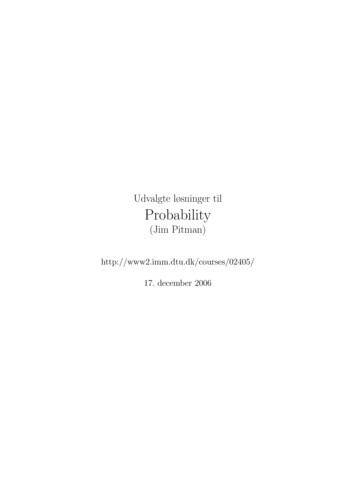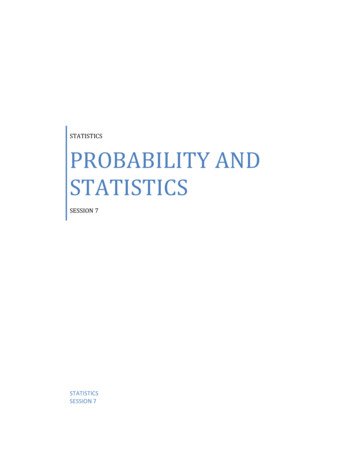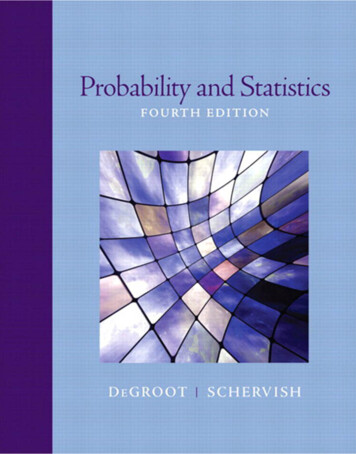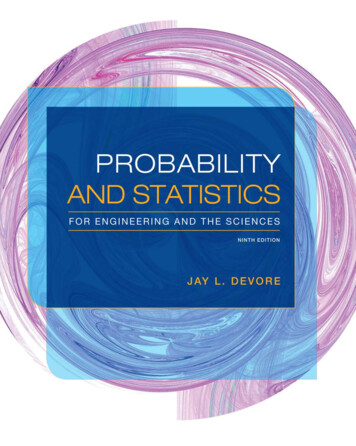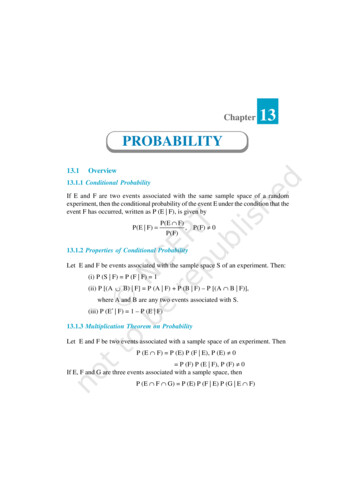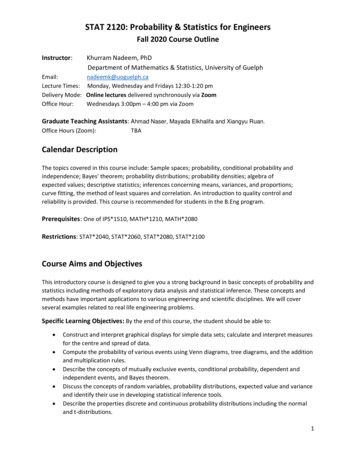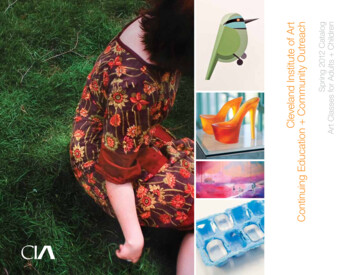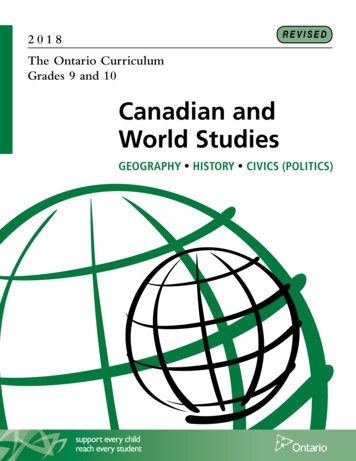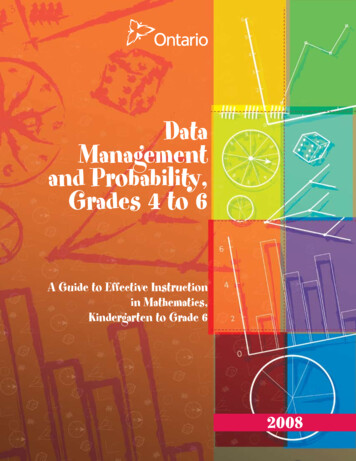
Transcription
DataManagementand Probability,Grades 4 to 6A Guide to Effective Instructionin Mathematics,Kindergarten to Grade 62008
DataManagementand Probability,Grades 4 to 6A Guide to Effective Instructionin Mathematics,Kindergarten to Grade 6
Every effort has been made in this publication to identify mathematics resources andtools (e.g., manipulatives) in generic terms. In cases where a particular product is usedby teachers in schools across Ontario, that product is identified by its trade name, in theinterests of clarity. Reference to particular products in no way implies an endorsement ofthose products by the Ministry of Education.
ContentsIntroduction1The Pleasure of Mathematical Surprise and Insight.1Working Towards Equitable Outcomes for Diverse Students.2Accommodations and Modifications.3The Mathematical Processes.6Addressing the Needs of Junior Learners.8Learning About Data Management and Probability in the Junior Grades. 10The “Big Ideas” of Data Management and Probability11About Big Ideas. 11About the Teaching and Learning of Data Management and Probability. 13Big Ideas and Tiered Instruction. 14The Big Ideas of Data Management and Probability in Grades 4 to 6. 16Collection and Organization of Data20Overview. 20Example: Favourite TV Shows. 20Method 1: Matching Questions With Methods of Data Collectionand Organization. 21Method 2: Extending the Problem. 24Data Relationships26Overview. 26Example: The Masses of Backpacks. 26Method 1: Understanding Data Relationships. 27Method 2: Exploring Data Relationships Through Project-Based Learning. 30Probability31Overview. 31Example: The Sum of Two Number Cubes. 31Method 1: Experimental Probability. 32Method 2: Theoretical Probability. 34
References36Learning Activities37Introduction to the Learning Activities. 39Grade 4 Learning Activities41Too Much TV(Collection and Organization of Data; Data Relationships). 41Heads or Tails?(Probability). 55Grade 5 Learning Activities68Daily Physical Activity(Collection and Organization of Data; Data Relationships). 68Lost Socks(Probability). 81Grade 6 Learning Activities93Paper Airplane Contest(Collection and Organization of Data; Data Relationships). 93Rock-Paper-Scissors(Probability).104Appendix: Guidelines for Assessment115Glossary119
8234567195783241/24/1623IntroductionData Management and Probability, Grades 4 to 6 is a practical guide that teachers will finduseful in helping students to achieve the curriculum expectations outlined for Grades 4 to 6in the Data Management and Probability strand of The Ontario Curriculum, Grades 1–8:Mathematics, 2005. This guide provides teachers with practical applications of the principlesand theories that are elaborated in A Guide to Effective Instruction in Mathematics,Kindergarten to Grade 6, 2006.The first part of the guide provides a detailed discussion of the three “big ideas”, or majormathematical themes, in Data Management and Probability, and provides a discussion ofmathematical models and instructional strategies that have proved effective in helpingstudents understand the mathematical concepts related to each big idea. The guide emphasizesthe importance of focusing on the big ideas in mathematical instruction to achieve the goalof helping students gain a deeper understanding of mathematical concepts. At the end of the firstpart of the guide is a list of references cited.The second part of the guide provides sample learning activities, for Grades 4, 5, and 6, thatillustrate how a learning activity can be designed to: focus on an important curriculum topic; involve students in applying the seven mathematical processes described in the mathematicscurriculum document; develop understanding of the big ideas in Data Management and Probability.At the end of the second part of the guide is an appendix that discusses assessment strategiesfor teachers. There is also a glossary that includes mathematical and other terms that areused in the guide.The Pleasure of Mathematical Surprise and InsightYoung children enter school mathematically curious, imaginative, and capable. They haveto learn to be otherwise (Papert, 1980). The aim of this resource is to help consolidateand extend junior students’ mathematical capacity and their potential for mathematicalgrowth by providing ideas and classroom activities that draw their attention to relationshipsembedded in the big ideas of the Data Management and Probability strand in the Ontario
mathematics curriculum and that offer them opportunities to experience the pleasure ofmathematical surprise and insight (Gadanidis, 2004).The activities in this resource incorporate the ideas and practice of classroom teachers. Theactivities have been field-tested in Ontario classrooms, and feedback from practisingteachers has been used to create the final versions. The chapter “The ‘Big Ideas’ of DataManagement and Probability” (pp. 11–19) discusses the big ideas on which the activitieshave been built and contains additional ideas for classroom activities.The teaching of mathematics around big ideas offers students opportunities to develop asophisticated understanding of mathematics concepts and processes, and helps them tomaintain their interest in and excitement about doing and learning mathematics.Working Towards Equitable Outcomes for Diverse StudentsAll students, whatever their socio-economic, ethnocultural, or linguistic background, musthave opportunities to learn and to grow, both cognitively and socially. When students canmake personal connections to their learning, and when they feel secure in their learningenvironment, their true capacity will be realized in their achievement. A commitment toequity and inclusive instruction in Ontario classrooms is therefore critical to enabling allstudents to succeed in school and, consequently, to become productive and contributingmembers of society.To create effective conditions for learning, teachers must take care to avoid all forms ofbias and stereotyping in resources and learning activities, which can quickly alienatestudents and limit their learning. Teachers should be aware of the need to provide a varietyof experiences and to encourage multiple perspectives, so that the diversity of the class isrecognized and all students feel respected and valued. Learning activities and resources forteaching mathematics should be inclusive, providing examples and illustrations and usingapproaches that recognize the range of experiences of students with diverse backgrounds,knowledge, skills, interests, and learning styles.The following are some strategies for creating a learning environment that acknowledgesand values the diversity of students and enables them to participate fully in the learningexperience: providing mathematics problems with situations and contexts that are meaningful to allstudents (e.g., problems that reflect students’ interests, home-life experiences, and culturalbackgrounds and that arouse their curiosity and spirit of enquiry); using mathematics examples drawn from diverse cultures, including Aboriginal peoples’; using children’s literature that reflects various cultures and customs as a source of mathematical examples and situations; understanding and acknowledging customs and adjusting teaching strategies as necessary. Data Management and Probability, Grades 4 to 6
For example, a student may come from a culture in which it is considered inappropriatefor a child to ask for help, express opinions openly, or make direct eye contact with anadult; considering the appropriateness of references to holidays, celebrations, and traditions; providing clarification if the context of a learning activity is unfamiliar to students(e.g., describing or showing a food item that may be new to some students); evaluating the content of mathematics textbooks, children’s literature, and supplementarymaterials for cultural or gender bias; designing learning and assessment activities that allow students with various learningstyles (e.g., auditory, visual, tactile/kinaesthetic) to participate meaningfully; providing opportunities for students to work both independently and interdependentlywith others; providing opportunities for students to communicate orally and in writing in their homelanguage (e.g., pairing an English language learner with a first-language peer who alsospeaks English); using diagrams, pictures, manipulatives, sounds, and gestures to clarify mathematicalvocabulary that may be new to English language learners.For a full discussion of equity and diversity in the classroom, as well as a detailed checklistfor providing inclusive mathematics instruction, see pages 34–40 in Volume 1 of A Guide toEffective Instruction in Mathematics, Kindergarten to Grade 6, 2006.Accommodations and ModificationsThe learning activities in this document have been designed forstudents with a range of learning needs. Instructional and assessment tasks are open-ended, allowing most students to participatefully in learning experiences. In some cases, individual studentsmay require accommodations and/or modifications, in accordancewith their Individual Education Plan (IEP), to support theirparticipation in learning activities.PROVIDING ACCOMMODATIONSStudents may require accommodations, including special strategies, support, and/or equipment to allow them to participate inlearning activities. There are three types of accommodations: Instructional accommodations are adjustments in teaching strategies, including styles of presentation, methods of organization,or the use of technology or multimedia.The term accommodations isused to refer to the special teaching and assessment strategies,human supports, and/or individualized equipment requiredto enable a student to learnand to demonstrate learning.Accommodations do not alter theprovincial curriculum expectationsfor the grade.Modifications are changes madein the age-appropriate gradelevel expectations for a subject in order to meet a student’slearning needs. These changesmay involve developing expectations that reflect knowledge andskills required in the curriculumfor a different grade level and/orincreasing or decreasing thenumber and/or complexity of theregular grade-level curriculumexpectations.(Ontario Ministry of Education,2004, pp. 25–26)Introduction
Environmental accommodations are supports or changes that the student may require in thephysical environment of the classroom and/or the school, such as preferential seating orspecial lighting. Assessment accommodations are adjustments in assessment activities and methods thatenable the student to demonstrate learning, such as allowing additional time to completetasks or permitting oral responses to test questions.Some of the ways in which teachers can provide accommodations with respect to mathematics learning activities are listed in the following chart.Instructional Accommodations Vary instructional strategies, using different manipulatives, examples, and visuals (e.g., concretematerials, pictures, diagrams) as necessary to aid understanding. Rephrase information and instructions to make them simpler and clearer. Use non-verbal signals and gesture cues to convey information. Teach mathematical vocabulary explicitly. Have students work with a peer. Structure activities by breaking them into smaller steps. Model concepts using concrete materials and computer software, and encourage students to usethem when learning concepts or working on problems. Have students use calculators and/or addition and multiplication grids for computations. Format worksheets so that they are easy to understand (e.g., use large-size font; an unclutteredlayout; spatial cues, such as arrows; colour cues). Encourage students to use graphic organizers and square grid paper to organize ideas and writtenwork. Provide augmentative and alternative communications systems. Provide assistive technology, such as text-to-speech software. Provide time-management aids (e.g., checklists). Encourage students to verbalize as they work on mathematics problems. Provide access to computers. Reduce the number of tasks to be completed. Provide extra time to complete tasks.Environmental Accommodations Provide an alternative workspace. Seat students strategically (e.g., near the front of the room; close to the teacher in group settings; witha classmate who can help them). Reduce visual distractions. Minimize background noise. Provide a quiet setting. Provide headphones to reduce audio distractions. Provide special lighting. Provide assistive devices or adaptive equipment. Data Management and Probability, Grades 4 to 6
Assessment Accommodations Have students demonstrate understanding using concrete materials, using computer software,or orally rather than in written form. Have students record oral responses on audiotape. Have students’ responses on written tasks recorded by a scribe. Provide assistive technology, such as speech-to-text software. Provide an alternative setting. Provide assistive devices or adaptive equipment. Provide augmentative and alternative communications systems. Format tests so that they are easy to understand (e.g., use large-size font; an uncluttered layout;spatial cues, such as arrows; colour cues). Provide access to computers. Provide access to calculators and/or addition and multiplication grids. Provide visual cues (e.g., posters). Provide extra time to complete problems or tasks or answer questions. Reduce the number of tasks used to assess a concept or skill.MODIFYING CURRICULUM EXPECTATIONSStudents who have an IEP may require modified expectations, which differ from the regulargrade-level curriculum expectations. When developing modified expectations, teachersmake important decisions regarding the concepts and skills that students need to learn.Most of the learning activities in this document can be adapted for students who requiremodified expectations. The following chart provides examples of how a teacher coulddeliver learning activities that incorporate individual students’ modified expectations.Modified ProgramWhat It MeansExampleModified learning expectations, same activity, samematerialsThe student with modifiedexpectations works on the sameor a similar activity, using thesame materials.The learning activity involvesrepresenting a probability as afraction. Students with modified expectations representthe probability using an areamodel.Modified learning expectations, same activity, differentmaterialsThe student with modifiedexpectations engages in thesame activity but uses differentmaterials that enable him/herto remain an equal participantin the activity.The activity involves creatinga bar graph to display data.Students with modifiedexpectations can use statisticalsoftware to create the bargraph.(continued)Introduction
Modified ProgramModified learning expectations, different activity,different materialsWhat It MeansStudents with modified expectations participate in differentactivities.ExampleStudents with modifiedexpectations work on datamanagement and probabilityactivities that reflect theirlearning expectations, usinga variety of materials andtechnological tools.(Adapted from Education for All: The Report of the Expert Panel on Literacy and Numeracy Instruction forStudents With Special Education Needs, Kindergarten to Grade 6, p. 119.)It is important to note that some students may require both accommodations and modifiedexpectations.The Mathematical ProcessesThe Ontario Curriculum, Grades 1–8: Mathematics, 2005 identifies seven mathematicalprocesses through which students acquire and apply mathematical knowledge and skills.The mathematical processes that support effective learning in mathematics are as follows: problem solving connecting reasoning and proving representing reflecting communicating selecting tools andcomputational strategiesThe learning activities in this guide demonstrate how the mathematical processes helpstudents develop mathematical understanding. Opportunities to solve problems, to reasonmathematically, to reflect on new ideas, and so on, make mathematics meaningful forstudents. The learning activities also demonstrate that the mathematical processes areinterconnected – for example, problem-solving tasks encourage students to represent mathematical ideas, to select appropriate tools and strategies, to communicate and reflect onstrategies and solutions, and to make connections between mathematical concepts.Problem Solving: Each of the learning activities is structured around a problem or aninquiry. As students solve problems or conduct investigations, they make connectionsbetween new mathematical concepts and ideas that they already understand. The focuson problem solving and inquiry in the learning activities also provides opportunities forstudents to: find enjoyment in mathematics; develop confidence in learning and using mathematics; Data Management and Probability, Grades 4 to 6
work collaboratively and talk about mathematics; communicate ideas and strategies; reason and use critical thinking skills; develop processes for solving problems; develop a repertoire of problem-solving strategies; connect mathematical knowledge and skills with situations outside the classroom.Reasoning and Proving: The learning activities described in this document provide opportunities for students to reason mathematically as they explore new concepts, develop ideas,make mathematical conjectures, and justify results. The learning activities include questionsthat teachers can use to encourage students to explain and justify their mathematical thinking,and to consider and evaluate the ideas proposed by others.Reflecting: Throughout the learning activities, students are asked to think about, reflecton, and monitor their own thought processes. For example, questions posed by the teacherencourage students to think about the strategies they use to solve problems and to examinethe mathematical ideas that they are learning. In the Reflecting and Connecting part ofeach learning activity, students have an opportunity to discuss, reflect on, and evaluatetheir problem-solving strategies, solutions, and mathematical insights.Selecting Tools and Computational Strategies: Mathematical tools, such as manipulatives,pictorial models, and computational strategies, allow students to represent and do mathematics. The learning activities in this document provide opportunities for students to selecttools (concrete, pictorial, and symbolic) that are personally meaningful, thereby allowingindividual students to solve problems and to represent and communicate mathematicalideas at their own level of understanding.Connecting: The learning activities are designed to allow students of all ability levels toconnect new mathematical ideas to what they already understand. The learning activitydescriptions provide guidance to teachers on ways to help students make connectionsamong concrete, pictorial, and symbolic mathematical representations. Advice on helpingstudents develop conceptual understanding is also provided. The problem-solving experiencein many of the learning activities allows students to connect mathematics to real-life situations and meaningful contexts.Representing: The learning activities provide opportunities for students to represent mathematical ideas by using concrete materials, pictures, diagrams, numbers, words, and symbols.Representing ideas in a variety of ways helps students to model and interpret problemsituations, understand mathematical concepts, clarify and communicate their thinking, andmake connections between related mathematical ideas. Students’ own concrete and pictorialrepresentations of mathematical ideas provide teachers with valuable assessment informationabout student understanding that cannot be assessed effectively using paper-and-pencil tests.Introduction
Communicating: Communication of mathematical ideas is an essential process in learningmathematics. Throughout the learning activities, students have opportunities to expressmathematical ideas and understandings orally, visually, and in writing. Often, students areasked to work in pairs or in small groups, thereby providing learning situations in whichstudents talk about the mathematics that they are doing, share mathematical ideas, and askclarifying questions of their classmates. These oral experiences help students to organizetheir thinking before they are asked to communicate their ideas in written form.Addressing the Needs of Junior LearnersEvery day, teachers make many decisions about instruction in their classrooms. To makeinformed decisions about teaching mathematics, teachers need to have an understanding ofthe big ideas in mathematics, the mathematical concepts and skills outlined in the curriculumdocument, effective instructional approaches, and the characteristics and needs of learners.The following chart outlines general characteristics of junior learners and describes someof the implications of these characteristics for teaching mathematics to students inGrades 4, 5, and 6.Area s ofJunior LearnersImplications for TeachingMathematicsGenerally, students in the juniorgrades:The mathematics program shouldprovide: prefer active learning experiencesthat allow them to interact withtheir peers; learning experiences that allowstudents to actively explore andconstruct mathematical ideas; are curious about the worldaround them; learning situations that involve theuse of concrete materials; are at a concrete, operationalstage of development, and areoften not ready to think abstractly; opportunities for students to seethat mathematics is practical andimportant in their daily lives; enjoy and understand the subtleties of humour. enjoyable activities that stimulatecuriosity and interest; tasks that challenge students toreason and think deeply aboutmathematical ideas.(continued) Data Management and Probability, Grades 4 to 6
Area ofDevelopmentPhysicalDevelopmentCharacteristics ofJunior LearnersImplications for TeachingMathematicsGenerally, students in the juniorgrades:The mathematics program shouldprovide: experience a growth spurt beforepuberty (usually at age 9–10 forgirls, at age 10–11 for boys); opportunities for physical movement and hands-on learning; are concerned about body image; a classroom that is safe and physically appealing. are active and energetic; display wide variations in physicaldevelopment and maturity.PsychologicalDevelopmentGenerally, students in the juniorgrades:The mathematics program shouldprovide: are less reliant on praise, but stillrespond well to positive feedback; ongoing feedback on students’learning and progress; accept greater responsibility fortheir actions and work; an environment in which studentscan take risks without fear ofridicule; are influenced by their peergroups. opportunities for students toaccept responsibility for theirwork; a classroom climate that supportsdiversity and encourages allmembers to work cooperatively.Social DevelopmentGenerally, students in the juniorgrades:The mathematics program shouldprovide: are less egocentric, yet requireindividual attention; opportunities to work with othersin a variety of groupings (pairs,small groups, large group); can be volatile and changeable inregard to friendship, yet want tobe part of a social group; can be talkative; are more tentative and unsure ofthemselves;Moral and EthicalDevelopment opportunities to discuss mathematical ideas; clear expectations of what isacceptable social behaviour; mature socially at different rates. learning activities that involve allstudents regardless of ability.Generally, students in the juniorgrades:The mathematics program shouldprovide: develop a strong sense of justiceand fairness; learning experiences that provideequitable opportunities forparticipation by all students; experiment with challenging thenorm and ask “why” questions; begin to consider others’ points ofview. an environment in which all ideasare valued; opportunities for students to sharetheir own ideas, and evaluate theideas of others.(Adapted, with permission, from Making Math Happen in the Junior Years. Elementary Teachers’Federation of Ontario, 2004.)Introduction
Learning About Data Management and Probabilityin the Junior GradesThe development of an understanding of data management and probability concepts andrelationships is a gradual one, moving from experiential and physical learning to theoreticaland inferential learning. Data management and probability thinking in the junior yearsbegins to bridge the two.PRIOR LEARNINGIn the primary grades, students learn to collect and organize discrete primary data and todisplay data using concrete representations, as well as charts and bar graphs. They learn toread, describe, and interpret primary data presented in charts and graphs. They predict andinvestigate the frequency of a specific outcome in a simple probability experiment. Learningabout data management and probability allows students to develop the concepts andlanguage they need for understanding data and chance in the world around them.Experiences in the primary classroom include sorting and classifying objects into categories;conducting simple surveys; organizing and displaying data in charts, tables, and graphs; reading,describing, and drawing conclusions from primary data; predicting the frequency of an outcomein a simple probability experiment; and investigating the concept of fairness in games.KNOWLEDGE AND SKILLS DEVELOPED IN THE JUNIOR GRADESIn the junior grades, students continue to collect, organize, display, and interpret primarydata, and explore simple probability. They also learn to deal with secondary data and todisplay and read data presented in a greater variety of forms, such as double bar graphs andstem-and-leaf plots. They extend their understanding of mode and develop an understandingof median and mean. They also extend their knowledge of probability. Junior students developa more sophisticated and abstract understanding of probability and start developing theirknowledge of theoretical probability. They use websites, such as E-Stat or Census at Schools;spreadsheets; and dynamic statistical software.Junior students extend their understanding of data management and probability relationships through investigation. They conduct surveys and probability experiments and solverelated problems. For example, “Would the results of a survey of primary students abouttheir favourite television shows represent the favourite shows of students in the entireschool? Why or why not? How might the survey be improved?” Or “Suppose you roll twonumber cubes and calculate the sum of the numbers rolled. Which sum is more likely: 2or 8? Conduct a probability experiment to test your hypothesis. Determine the theoreticalprobability for each sum.”Such problems offer junior students opportunities to use and extend their knowledge of datamanagement and probability. Data management and probability problems are often situatedin real-life settings. Instruction that is based on meaningful and relevant contexts helps students to achieve the curriculum expectations related to data management and probability.10Data Management and Probability, Grades 4 to 6
7234567881951/23244/1623The “Big Ideas” of DataManagement and ProbabilityAll learning, especially new learning, should be embedded in well-chosen contexts forlearning – that is, contexts that are broad enough to all
Data Management and Probability, Grades 4 to 6 is a practical guide that teachers will find useful in helping students to achieve the curriculum expectations outlined for Grades 4 to 6 in the Data Management and Probability strand of The Ontario Curriculum, Grades 1-8: Mathematics, 2005. This guide provides teachers with practical .
